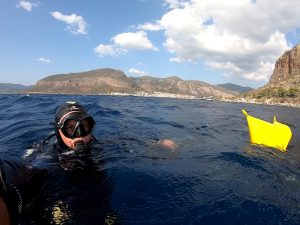Wreck in 35m water depth close to the cementery at Monemvasia.
April 26, 1941, 13:00 – Under the command of Captain Ioannis Gikas, loaded with 50,000,000 drachmas from the Bank of Greece and escorted by the torpedo boat KYDONIAI, attacked in Monemvasia (Peloponnese) by 12 German Luftwaffe aircraft with aerial bombs and machine guns , badly damaged and sunk together with the torpedo boat KYDONIAI without losses.
Her Story
1892 VICTORIA
1899 INSULAIRE
1910 EPEROKI
1932 ZAKYNTHOS
Following is a translation from an article (attached) on the P & K class torpedo boats published by Okrety Wojenne #128. It describes the loss of ZAKYNTHOS’ cargo and includes information that I collected from people that witnessed the sinking.
In April 1941 KYDONIAI was transferred to the control of the Fleet Commander-in -Chief and was thus included in the plan for the relocation of the fleet. On April 22, KYDONIAI was ordered to escort the requisitioned steamship ZAKYNTHOS to Suda. On board ZAKYNTHOS were 120 men from various recently sunk warships as well as craftsmen from the Naval Base, while she also carried 50 large cases with unnumbered bank notes from the Bank of Greece worth 50 million drachmas. Their orders were to sail only during the night and to spend daylight anchored near the coast in order to facilitate the disembarkation of the passengers in case of an air attack. However from the 36-strong crew of ZAKYNTHOS, only half of them were on board as the rest was not either unwilling to follow the ship or unable to reach her due to her hastily departure. The two ships left Megara at 15.00′ and headed towards the Aegina – Methana channel. At 17.00′ they anchored at Marathonas at Aegina in order for KYDONIAI to replenish her water tanks from ZAKYNTHOS. Half an hour later the two ships were attacked by German aircraft that dropped 9 to 12 bombs without scoring any hits.The two ships continued their southerly course after nightfall but due to ZAKYNTHOS slow speed of 8 knots, it was not possible to complete the trip to Suda during the darkness of the night. So in the dawn of April 23 they anchored in the southern bay of Monemvasia where the passengers of ZAKYNTHOS and members of their crews were taken ashore to find shelter from possible air attacks. Soon the ships were targeted by German aircraft and ZAKYNTHOS suffered some damage. Her Captain informed the commander of KYDONIAI, Lt.Commander A. Germanos that his crew refused to return to his ship. Germanos tried to gather the fugitive crew with the help of the local police but to no avail. The next days the two ships remained at Monemvasia and Germanos send a signal to the Fleet Commander-in-Chief requesting to be released from the duty to escort ZAKYNTHOS and to sail for Suda with his ship. He also informed that the morale of his crew was shaken and he kept control with gun in hand! The answer from the Fleet Command was only received on April 26 and ordered to have the boxes with the bank notes transferred to KYDONIAI and to sail to Suda with whoever was willing. The transfer had started when it was realized that due to their size, the boxes could only be placed on deck, something that affected the stability of KYDONAI. Lt. Commander Germanos informed the Fleet Command accordingly but before he received an answer, the two ships were attacked by Stuka aircraft. At about 13.00′ twelve dive bombers dropped forty bombs and sunk both ships. KYDONIAI that was moored stern first at Kourkoula, against the village’s cemetery, was the first to go. She received a hit that caused extensive structural damage to the hull. She remained floating for a while with her stern almost detached forming an angle with the rest of the hull. She then sunk bow first and the stern remained above the surface of the sea with the propellers in the air.
ZAKYNTHOS was hit while anchored off shore and fires soon broke all over the ship. She sunk and part of her cargo was soon floating on the sea. However the bank notes that were not yet stamped were worthless and the villagers that collected them were mocking calling them “stuka”.
(Source: forum-marinearchiv.de)








